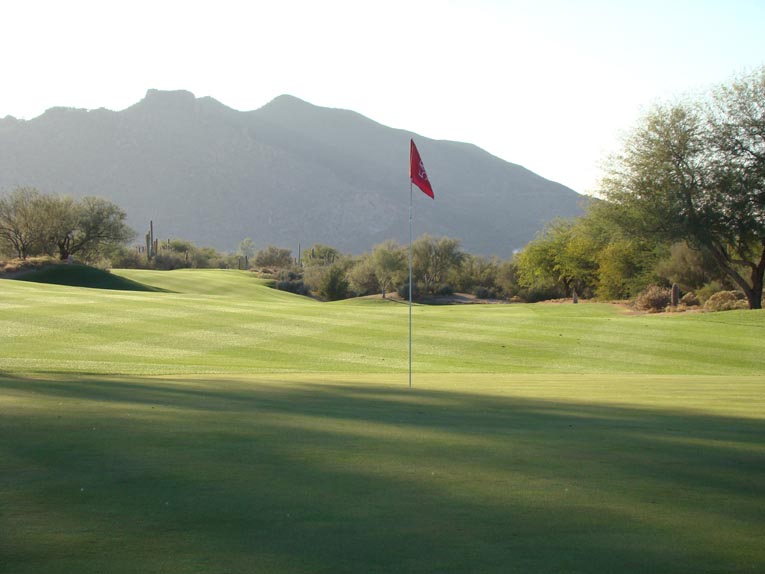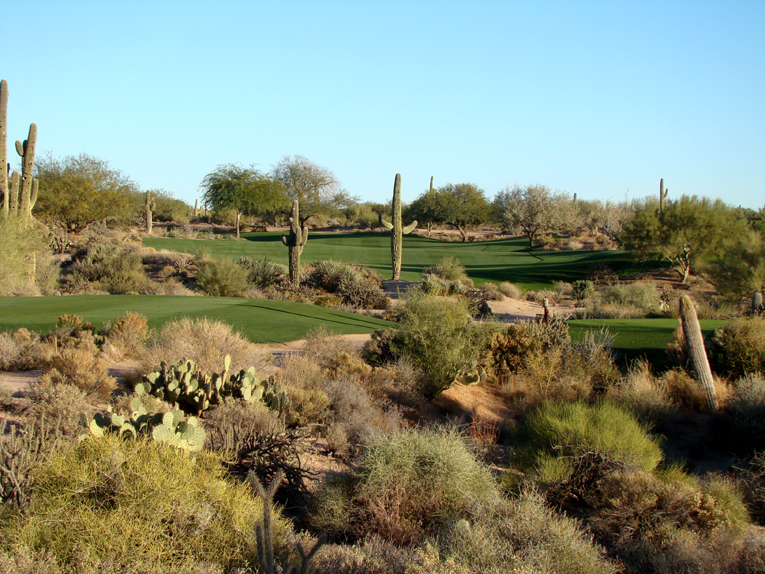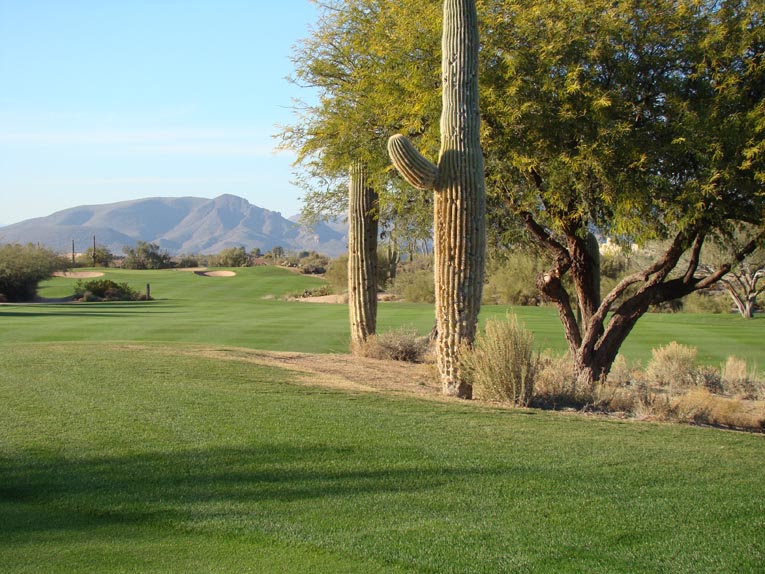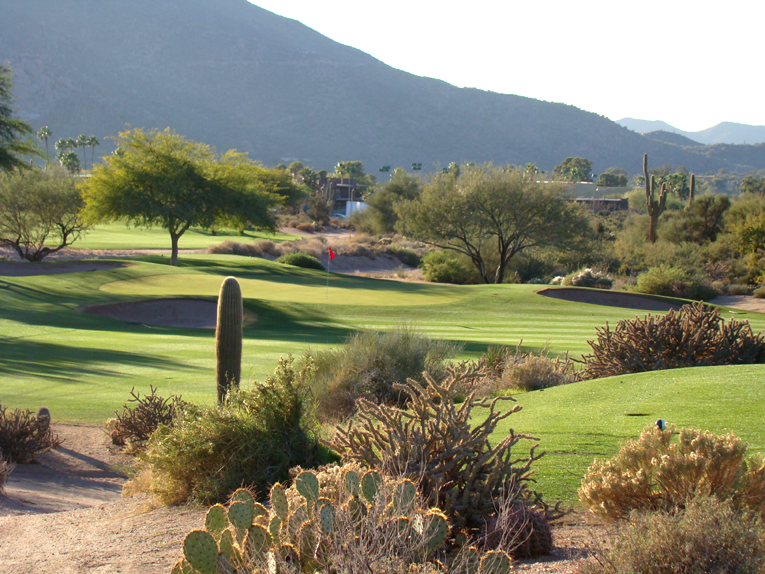Desert Forest Golf Club
Arizona, United States of America
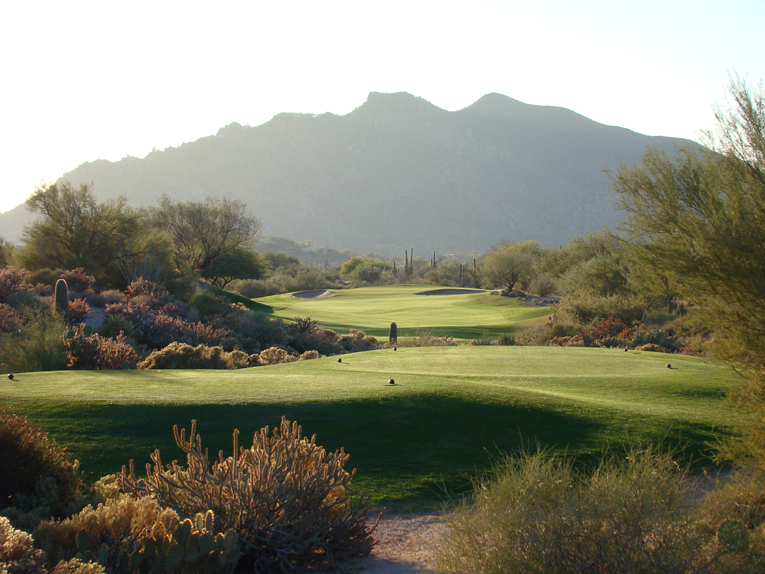
The charms of playing golf at Desert Forest under the clear blue skies against the backdrop of Black Mountain are as enchanting today as over four decades ago when Red Lawrence built the world’s first desert course.
Desert Forest was a true outpost when it opened for play in 1962. Surprisingly, it might be even more so today but more on that later!
Built 30 miles north of Phoenix in Carefree, Desert Forest is the original desert golf course. It was surrounded by nothing but the Sonoran Desert. The architect was Robert ‘Red’ Lawrence and rarely is an architect so tightly linked to just one design. While he worked on over thirty courses including the renowned University of New Mexico Golf Course, Desert Forest defined Lawrence’s career and earned him the moniker of the ‘desert fox’. Those of us who tracked Golf Digest’s US top 100 courses grew accustomed to seeing his name and Desert Forest highlighted when the magazine’s U.S. Top 100 rankings came out biannually.
His solo projects are mostly confined to the Southwest leading many to assume that Lawrence was from that region. How wrong they are! Few appreciate his deep roots in golf course architecture. Born in Westchester County, New York in 1883, he came along precisely when and where the highest concentration of great golf courses was being built in the United States.
Lawrence had the great fortune to work as an associate for William Flynn at some of Toomey & Flynn’s finest designs including The Country Club in the eastern suburbs of Cleveland, Huntingdon Valley outside of Philadelphia, and the Indian Creek Club in North Miami Beach. Additionally, he was with Flynn at the Merion Golf Club when it became the course we know today. After assisting Flynn build thirty-six holes at the Boca Raton Hotel, Lawrence remained there as Green Keeper weathering the drought of new golf projects during the Depression and World War II.
Lawrence went on to become a founding father of the American Society of Golf Course Architects in 1947 and relocated his own fledgling design practice from Florida to Arizona in 1958. Three years later he started on Desert Forest which became the showcase for desert golf and established how appealing such golf could be.
Lawrence spent time in the Northeast working on and studying some of the great historic designs there and his creation of Desert Forest represents a unique and vital link from the Golden Age to modern desert golf. Like Flynn, Lawrence excelled while moving little dirt from tee to green. His great achievement was how he successfully synthesized traditional shot values within the raw, picturesque desert. The sand and scrub serve as both hazard and backbone for cleverly designed fairways and greens. Only 67 of its 165 acres are maintained as turf and the rest remains pristine desert. Desert Forest enjoys an intimate routing of the sort one would hope and expect to find in a course that was intended to be walked.
What Lawrence seemed to appreciate better than most architects who have followed him is how to exploit the vastness of the desert in his design yet maintain a human scale on the course. Three to twelve foot landforms dominant play hole after hole: The domed fairway shunts balls left at the dogleg right first; the second fairway pivots left between natural twelve foot humps; a four foot deep swale behind the third green provides a tougher recovery than the four bunkers; the fourth fairway cants left to right; and so it goes.
The building boom in Arizona started in the 1980s fueled by the real estate market for second homes. With each passing decade, architects went higher and higher into the canyons in an attempt to outdo (and therefore outsell) the neighboring development. Photographic opportunities outweighed the consideration for what constituted good golf and architects built more and more stretched-out courses replete with intrusive home sites. Everything expanded: the number of tees, length of courses, number of sprinkler heads, distance between greens and tees, annual maintenance costs. Televised night matches even occurred. For most of us this expansion (explosion) subjugated the core values of the golf course.
All of this is an anathema to Desert Forest where tradition and dignified discretion mercifully carry the day. This becomes evident as soon as one turns off Mule Train Road into the club. The clubhouse remains unchanged, a low slung single story edifice that barely intrudes on its surrounds. Snuggled low, it is impressively out of sight from virtually everywhere on the course. Even on the handsome eighteenth fairway the golfer is left alone to appreciate the flora of the high desert.
The founders of Carefree and Desert Forest hired Red Lawrence to build a course for a golf club, not for real estate sales. They gave him an ample, rectangular block of contiguous land and the focus was purely to create golf of the sort that people would enjoy time and time again. Trite as the expression may be, Desert Forest epitomizes a ‘thinking man’s golf course.’ Its bending fairways create strategic dilemmas for the golfer who must often consider a a three wood, five wood or implement other than driver to best position his tee shot. The mindless power hitter has less chance of over-powering the course as one of his tee balls will eventually be greeted with a horrible fate. Though the playing corridors are wide, they call for precise tactics as the landforms make them play smaller. The long ball can be handsomely rewarded or cruelly punished. How should one handle the hump that protrudes into the second fairway? Is the turbo kick off the down slope in the sixteenth fairway really worth chancing a driver? The crowned fairway at the eighteenth sheds tee balls both left and right. Altogether these subtle features exert an appealing yet relentless pressure on the golfer to hold his composure with clear, tactical thinking.

The desert broom, staghorn, saguaro, creosote bush, turpentine bush, palo verde and mesquite seen above provide a rich and varied texture to a game of golf at Desert Forest. Note the absence of all non-indigenous plant life.
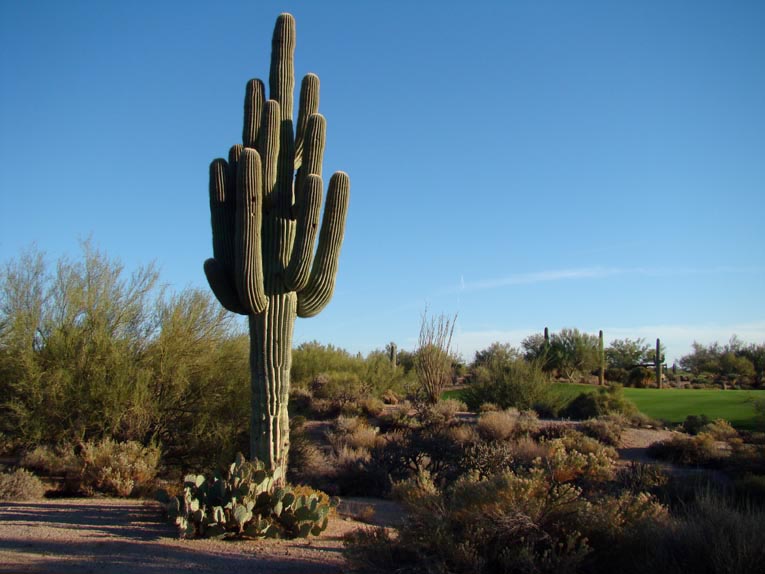
This specimen Saguaro with sixteen arms including the trunk is approximately 150 years old. It lives fifty yards short and right of the second green.
By its very definition, a desert is an inhospitable place with too little precipitation to sustain usual lifeforms. Decade after decade steady improvement in irrigation and agronomy made desert golf not only tenable but ubiquitous. A place like Phoenix that averages a mere 7 inches of annual rainfall has become a golf mecca. As it is, the sandy desert floor and its hardy vegetation serve as a delightfully stark contrast to the golf turf.
How much time Lawrence spent at Pine Valley is unknown but its influence in the form of island fairways, hostile vegetation and sloped putting surfaces is felt throughout a round here. When Desert Forest opened, the course measured slightly over 6,700 yards and that distance is preserved by playing ‘Red’s’ tees today. Tom Weiskopf extended several tees in 2000, especially the third, fifth, seventeenth and eighteenth so that the course can now play a punishing 7,100 yards. Given the pressure of ball control that the course continually exerts, Red’s tees are ample for anyone with a handicap and it’s 6,761 yards are referenced below.
Holes to Note
First hole, 375 yards; Though the back tees have been regularly tweaked, Desert Forest remains first and foremost a placement course. The challenge boils down to hitting fairway after fairway and placing one’s ball somewhere below the hole on the gracefully sloped greens. Matching the line off the tee to the correct distance is paramount with the first and second holes being prime examples. In the case of the first, the ideal position to approach the green is actually from the outside of the dogleg because of the green’s right to left cant. Hug the inside of the dogleg and you can be in the disadvantaged position of hitting across the green’s dominant slope.
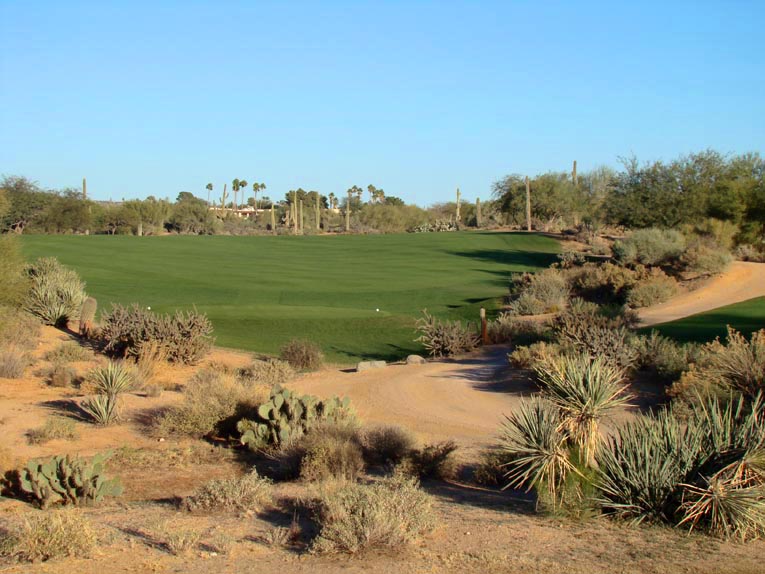
The tee ball at the first is typical of what one can expect at Desert Forest: A short forced carry that is of little concern with the real trouble being found left and right of the fairway. In this case, the fairway bends 80 degrees to the right so the golfer weighs a three wood straight or perhaps a driver to bite off a bit of the dogleg. Either way, he is unlikely to see where his ball lands as Lawrence was loath to touch the rolls found throughout the desert floor.

The uphill green sites at Desert Forest often appear simple but are actually complex affairs that feature broad slopes that beguile and frustrate. Lawrence’s opening green sets the tone and creates palpable tension. The approach must be deep enough to carry the front slope and avoid being rejected three to ten yards back into the fairway while not carrying too deep, leaving a nervy downhill putt.
Second hole, 430 yards; Gobs of fairway lie straight ahead but disappear into the desert at the 230 yard mark where the fairway jogs left. All options are available; lay back with a five wood, play a draw with a three wood or aggressively boom a drive over the foreboding desert. A clear plan needs to be formulated on the tee as the wrong line married with the wrong club is a sure recipe for disaster.
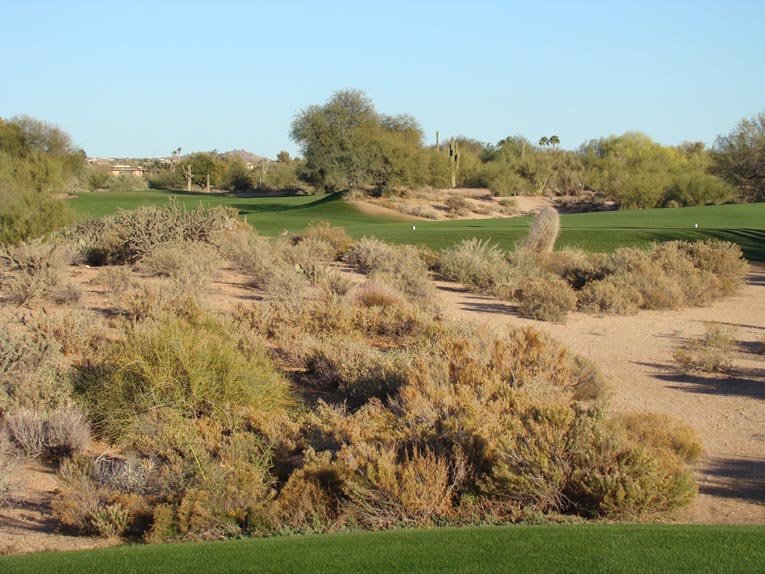
The second at Desert Forest is one of the great holes in the Southwest and beyond. It’s great feature is the exposed desert crater that Lawrence employed as a central hazard, bestowing both strategy and beauty.
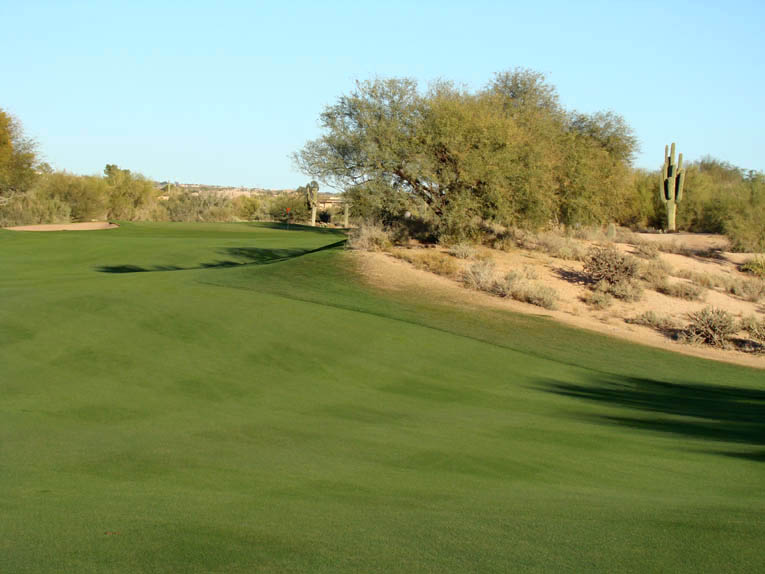
A straight 225 yard tee ball finishes in the shadow area of the fairway but leaves a long difficult approach. Can the golfer fit his tee ball farther left? Though not evident from tee, the left fairway slot is …
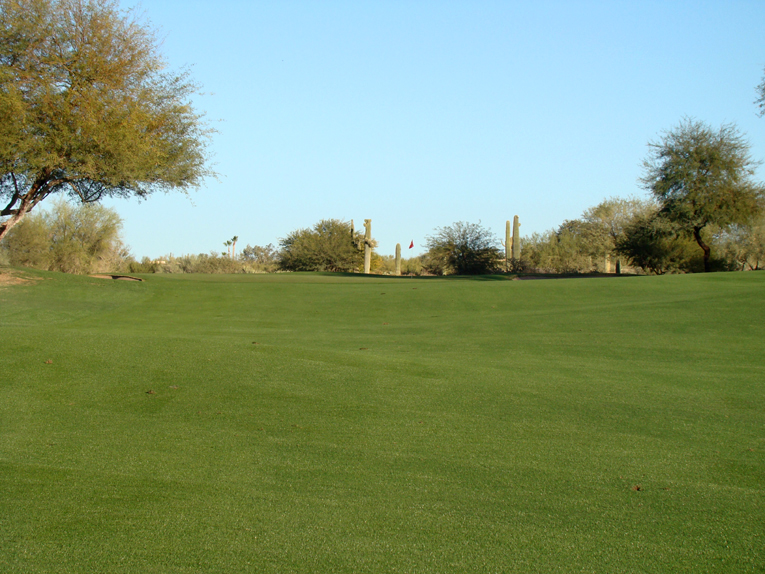
The approach to the second epitomizes how Lawrence worked at grade. He didn’t believe in building features that provided comfort or visual aid to the golfer.
Third hole, 165 yards; A pulpit green is such a wonder: Push dirt together and create a hit it or else proposition without additional fuss. That’s what Lawrence did here and the putting surface of 3,738 square feet is the second smallest target on the course. Yet, it plays smaller than the eighth green because its putting surface is crowned, tilting both to the front AND back from its high mid-section. Thanks to its elevated putting surface that sheds balls in all directions, the members have dubbed the third as ‘the shortest par 5 in the desert.’ The only good news is the four greenside bunkers aren’t perhaps as problematic as they were in Lawrence’s day given the advent of the 60 degree wedge. Indeed, facing the dilemma between recovering from a bunker or the swale behind the green, many golfers might opt for a sand explosion in order to get the needed elevation for their attempted recovery.
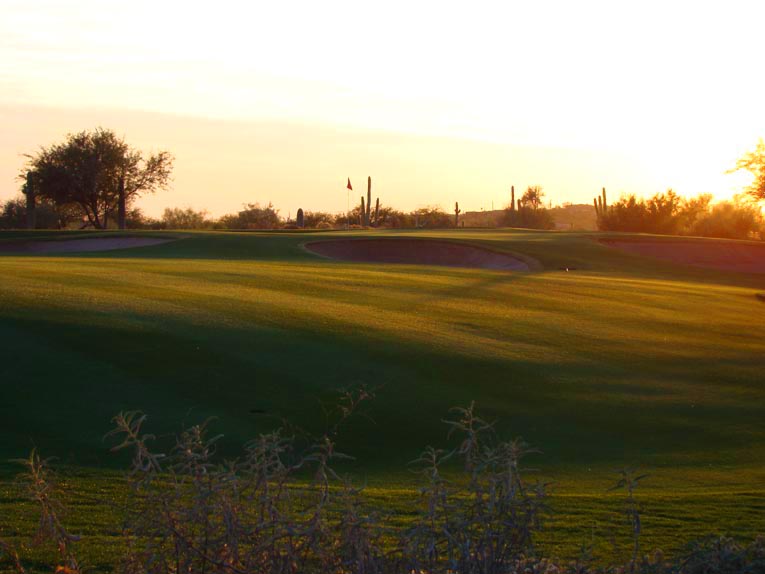
Ignore the day’s hole location and be content for the middle of this none too deep green. Notice – and admire – the clean lines of the green complex.
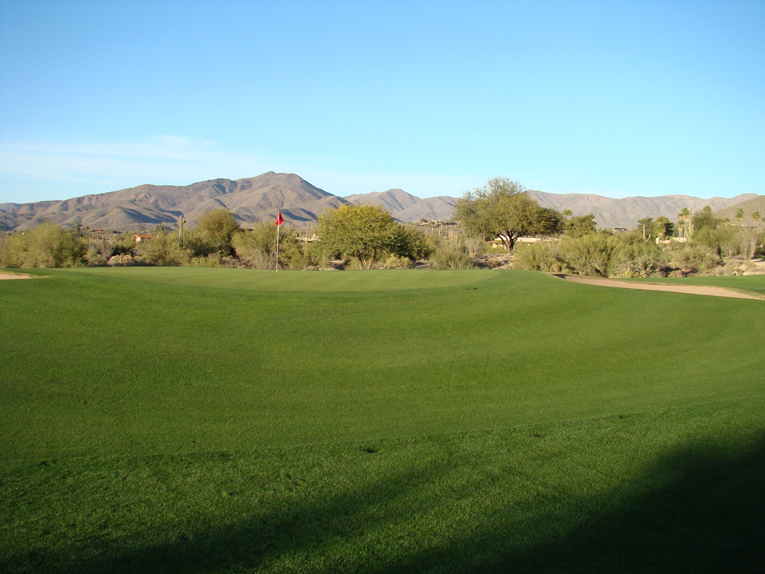
Short grass around the greens plays a prominent role at Desert Forest. This tightly mown bank back left of the third green is indicative of the type recovery shot that a golfer can expect should he miss greens.
Fifth hole, 405 yards; During his twenty years in Florida Lawrence became good friends with the Silver Scot, Tommy Armour and developed an appreciation for good golf and shotmaking. His designs encourage one to shape the ball flight. Given the superb firm conditions that the Director of Agronomy Todd Storm provides, the right to left tilt of the green dictates hugging the inside of this dogleg left. As one shys to the right with his tee ball, his approach increases with difficulty as it comes in across the cant of the green. Thus, the talented, old school player relishes the chance to showcase his ball striking skills by playing a draw off the tee into prime position and then a fade to control his ball on the swift right to left sloping green. A low draw approach is almost guaranteed to catch the green’s slope and end up in the short grass area left of the green.

… and avoid the desert floor to the left to enjoy the best angle into the uphill green that is canted from right to left.

Other than hitting the hole, this misplaced golfer has little chance of recovery from the six foot deep right greenside bunker to a short-sided hole location.
Seventh hole, 535 yards; This alternate route hole is the exact sort of design that one hopes to find in the desert and the seventh remains the gold standard forty-two years after Lawrence built it. This 1962 creation is even more noteworthy/impressive because architecture at the time was fairly straightforward, leaning more toward penal than strategic. To state that Lawrence’s Desert Forest was cutting edge and bucked convention is no exaggeration. Given that it is the course’s most famous hole, one is surprised to find such a grand hole buried on the outward nine. Yet, there is a reason for that as the two nines were reversed after one season when the club realized that the setting sun impacted play too greatly on the last two westerly facing holes of this nine. Regardless of where it falls in the round, the seventh remains a magical hole of strategic design.
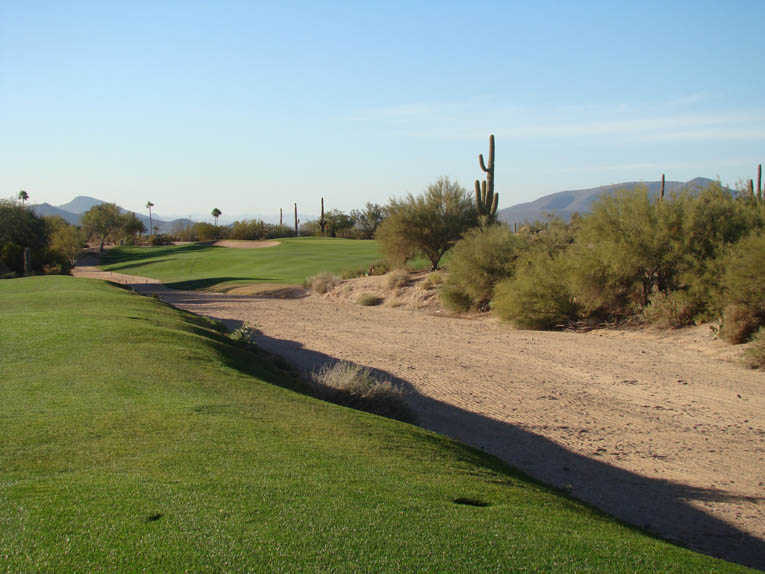
A thousand yard long wash cuts across the northern top of the property. Lawrence brilliantly captures it within the long seventh as a diagonal hazard.

The sunken wash is marked by the vegetation ahead. Even from this ‘go-zone’ spot 225 yards from the green, the golfer can discern the need to have his ball scoot past the green’s false front on this uphill approach.
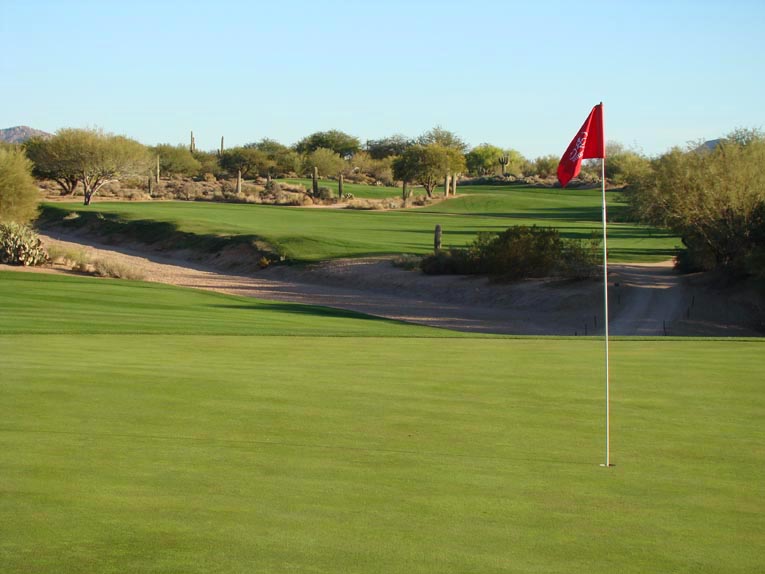
As seen from behind, all the great design features are evident: The alternate fairways in the distance, the wash that slashes across the fairway 100 yards short of the green, and the front of the putting surface that drops precipitously.
Eighth hole, 200 yards & Twelfth hole, 180 yards; Compare these two one shotters and appreciate Lawrence’s talent for creating variety within the same environment. The eighth plays downhill to the smallest green (3,700 square feet) on the course. Everything is visible from the tee, including that the front portion of the green which slopes toward the tee while the back falls away. Conversely, the twelfth plays uphill more than one suspects to a putting surface that is obscured behind two large right bunkers.
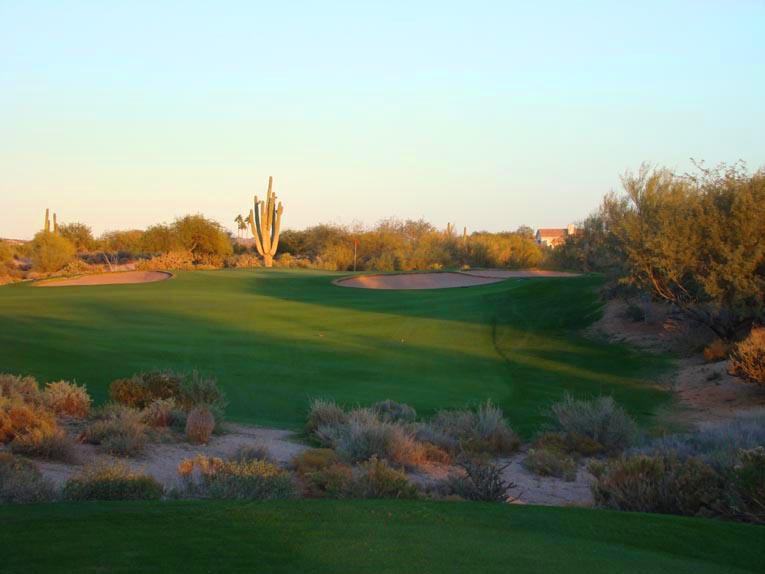
… the twelfth plays at least a half club longer than its yardage as it climbs uphill. When the flag is right, it looks like it is floating above the two right greenside bunkers. The green’s back right to front left slope is in fine contrast to the one at the eighth.
Eleventh hole, 560 yards; Flynn was a strong advocate of the true three shot golf hole and clearly Lawrence put stock in his mentor’s conviction. The alternate fairway, reachable par five seventh is perfectly offset by this uphill, nearly 600 yard beast. An architect today might become undone here as he wouldn’t enjoy the same advantage that Lawrence did in the early 1960s. Given that a dry wash fronting the green on a hole of this length would be too penal, Lawrence saw fit to turf over the dry wash that today would be protected by environmental/water laws that went into effect around 1980. Back in 1961, Lawrence was free to do just about anything that he wanted, as long as he stayed inside the budget of $300,000. These same water laws introduced the ‘blue lining’ that prevents washes from now being grassed, and set limits on acreage under irrigation for a course. At 65 acres of turf, Desert Forest is well below the limit of approximately 90 acres.
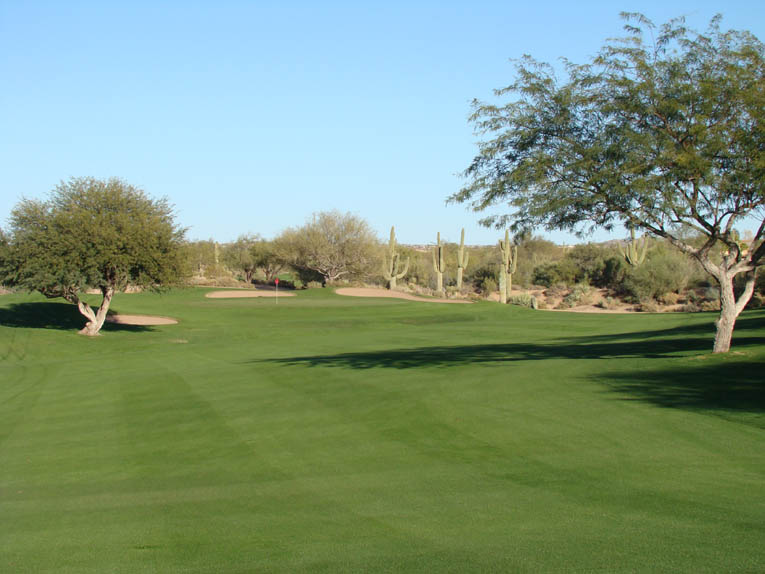
This photograph does not depict it well but in 1961 Lawrence had the opportunity/luxury to pull grass down and across a six foot deep wash that crossed in front of the eleventh green. What this photograph does highlight is the palo verde right and the mesquite left that the golfer needs to be mindful of when advancing his second shot up the fairway.
Thirteenth hole, 435 yards; As a broad generalization, the property at Desert Forest extends away from the clubhouse to the east on a slight incline in a self contained rectangle. Three of the four biggest two shotters (the second, fifth and thirteenth) play in an easterly direction, which is to say that they play up the incline. Thus, they play even longer than the scorecard suggests. At its choke point 130 yards from the green, the thirteenth fairway narrows to a scant twenty yards (!). Though the fairway landing zone and the 6,800 square foot green are ample in size, the thirteenth was voted the narrowest par 4 in Phoenix by a regional golf magazine several years ago.
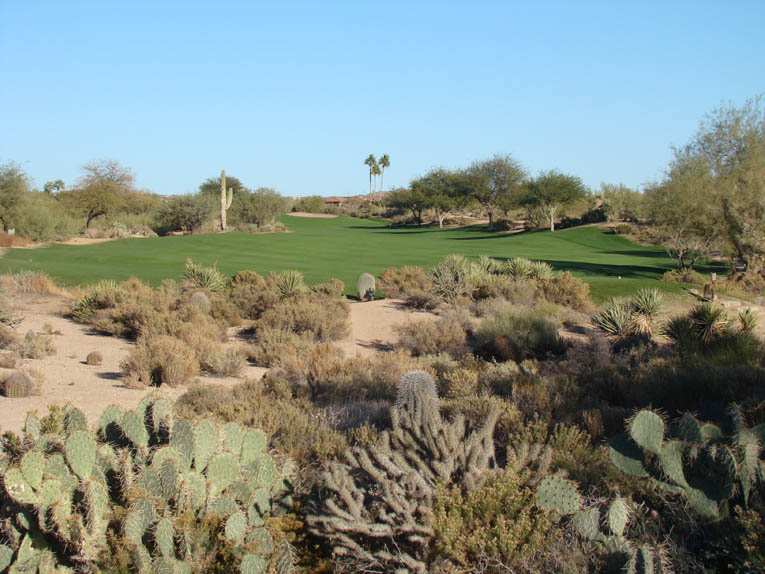
Though dauntingly long and narrow at one area, note how the fairway extends through the green (the bunker in the far distance is a right greenside one). Thus, even a 75 year old who hits it straight can feel good about the manner in which he is able to play the hole. Many other desert courses suffer from forced carries on holes of this length and thus tire a large percentage of golfers. Not here.
Fourteenth hole, 360 yards; Desert Forest is a beautifully proportioned course with the full gamut of holes. The long holes invariably feature bigger greens that are open in front while the shorter ones have more tightly defended targets. The pacing of the course is excellent too. The long, hard fifth is followed by the shortish sixth and again here the brute thirteenth is followed by a charmer. Despite its modest length, the left to right canted fairway and a green that slopes from front to back are features that turn this ‘breather’ into a surprisingly confounding sub-400 yard hole. The savy member tries to coax his approach just behind any right hole location as it gives him an uphill first putt.

The fourteenth heads toward Black Mountain and step one is to gear back to whatever club will most likely find the fairway.
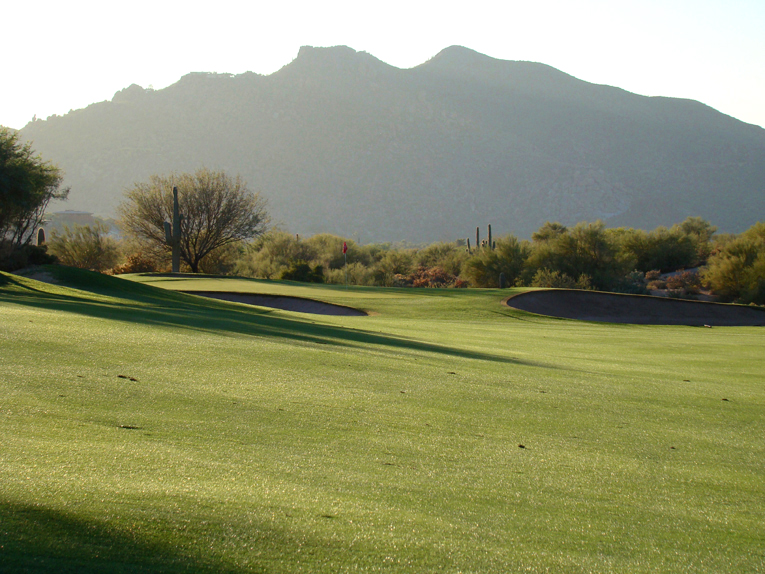
The left to right fairway slope does little to help the golfer put a good clean strike on his pitch. Spin is welcome as the green ….

… slopes away from the golfer, giving way to a tightly mown bank that wisks balls away to numerous undesirable locations.
Fifteenth hole, 370 yards; One reason that the author is such a fan of Desert Forest is that it plays mind games with the player via different ‘looks’ that the architect presents. Invariably, Lawrence provided plenty of room/short grass yet that might not be the impression for the golfer standing on the tee. Take the fifteenth where the fairway can look narrow at first glance. Truth be told, the landing area is almost twice as wide as the golfer’s eye tells him as Lawrence artfully tucked the left portion of the landing area beyond and below a covered hillock. This hole is but one more reason to favor the member in any match as he or she knows to swing away while the first timer might falter into steering mode. During the 2007 Women’s Mid-Amateur, many a golfer came undone on this straightaway hole.
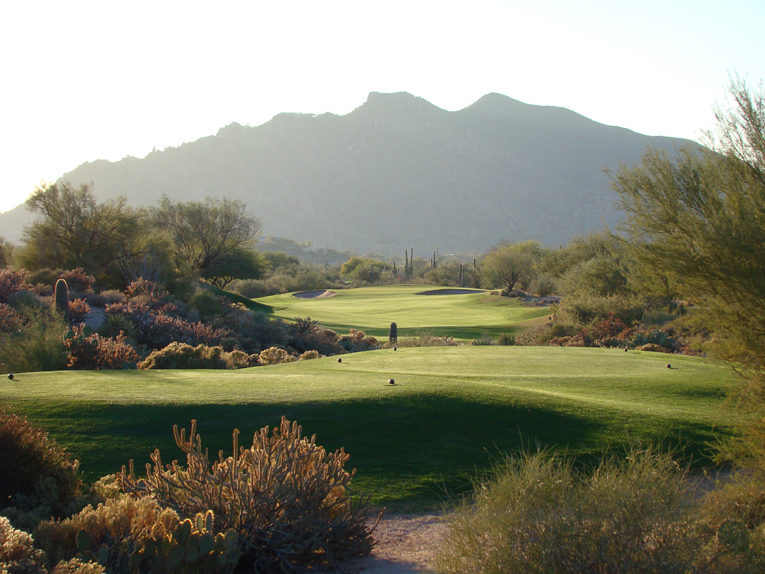
The view from the fifteenth tee is worrisome but the hillock on the left hides plenty of additional landing area.
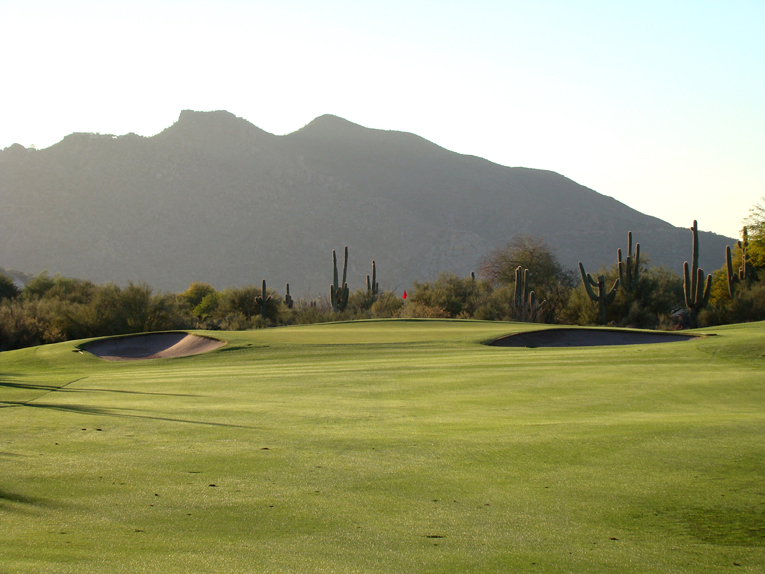
Once in the landing area, the hole feels spacious and unconfined. Indeed, discerning that the approach actually plays downhill isn’t easy.
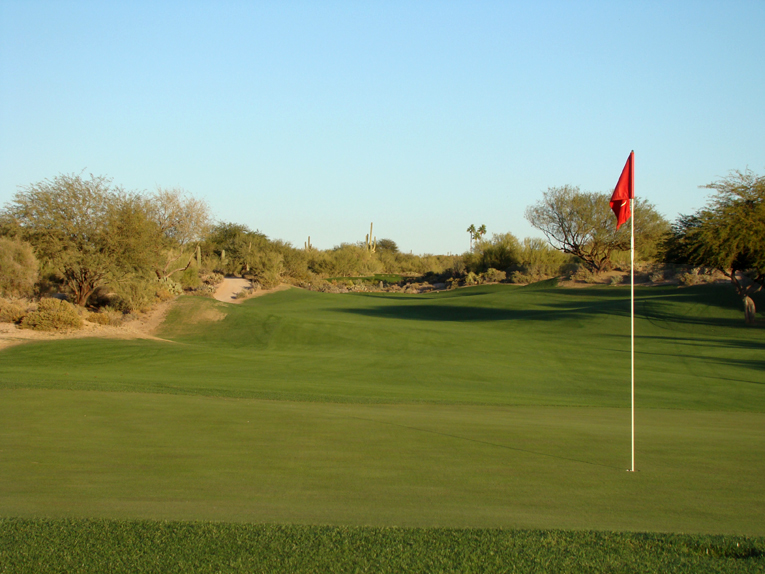
As seen from behind, the fifteenth fairway possesses plenty of width. It’s just that the area of the fairway anywhere near the flag stick above is largely unseen from the tee. Only upon leaving the green and looking back does the golfer gain a true appreciation of its downhill nature.
Sixteenth hole, 515 yards; All’s well that ends well and the switch of the two nines in 1963 worked well for the club. A host of world class courses (e.g. Pinehurst No.2, Shinnecock Hills, St. Enodoc, The Ocean Course at Kiawah) dramatize the sterling merit of a 5-3-4 finish. Pete Dye certainly was the adocate as he moved a lot of dirt to create such finishes at his most recognized courses including TPC at Sawgrass, PGA West, Whistling Straits, and the aforementioned Kiawah whereby an ‘eagle-able’ sixteenth gives way to two stern finishing holes. Lawrence would be pleased by how the open nature of the hole and long views to Black Mountain were restored when tall pines and other non-indigenous trees were removed along the right and behind the green.
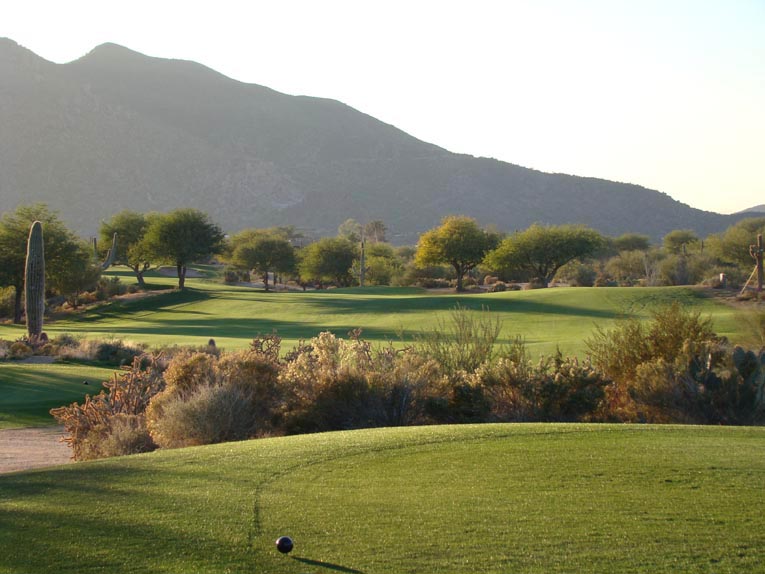
What a risk reward driving hole! A perfectly played draw gets a turbo boost off the back of the far hill and brings the green within reach in two. Miss it straight though and the golfer is apt to find misery in the desert.

A dream scenario finds one’s tee ball in this vicinity, leaving 230 yards to the green. The sixteenth epitomizes why Lawrence found no need for fairway bunkers. In this case, the landforms and mesquite tree captured within the fairway provide plenty of strategy. In fact, the mesquite tree is more effective than any central bunker as it effects play farther back than any bunker could.
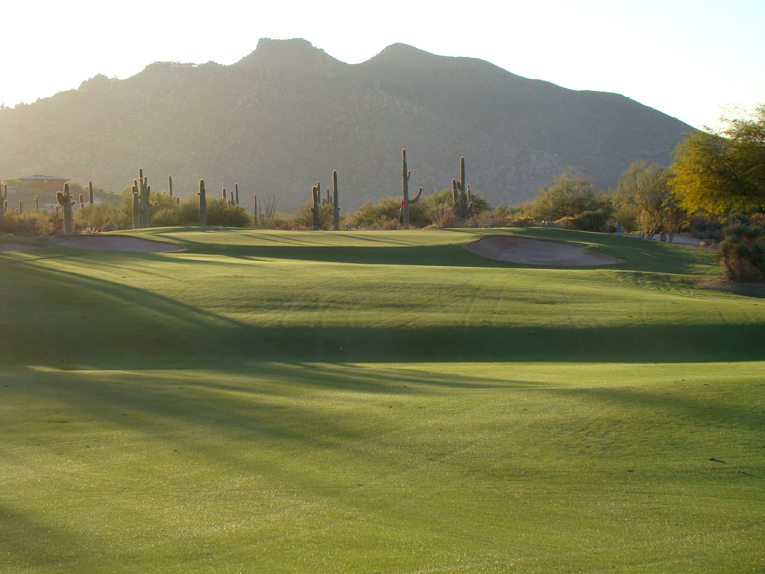
Here is an example of another wash that Lawrence was allowed to grass over in 1961. If he hadn’t, the landing area for a lay-up shot at the sixteenth would have been compromised and perhaps the hole might have been aborted. What a pity that would have been! Friendly legislation of the time helps Desert Forest retain its lofty status in desert golf as it enjoys built-in advantages that no longer exist.
Seventeenth hole, 160 yards; How does a 40 year old course stay relevant to the low marker? Given its prestigious position as the first and most famous desert course, Desert Forest desires to challenge the best while providing pleasure for its core membership of 50 plus year old golfers. How to balance both without violating the natural features and beauty of the desert? One way sure way to avoid the mess that 460cc drivers have created for 40 year old courses is to focus on the one shot holes. Sad but true: The iron that got the job done when the course opened still gets it done today for the elite player, thanks to a new tee built by Tom Weiskopf in 2000 that lengthened the hole by 50 (!) yards to 210 yards for those few good enough to play from the back. The other way a course remains relevant is by the merit of its greens, which are the ultimate target. Lawrence uses broad slopes as opposed to wild interior contours to lend many holes their enduring challenge. In this manner, his greens share similar playing characteristics to those of his mentor William Flynn. Note the photograph below. There is a back right plane that is relatively flat, the front third of the green slopes steeply toward the tee while the left third of the green features a broad slope to the left. Getting one’s ball into the correct position on these broad slopes lies at the heart of the matter. Do so properly throughout one’s round and the golfer leaves with a warm glow derived from a well executed, intelligent game plan.
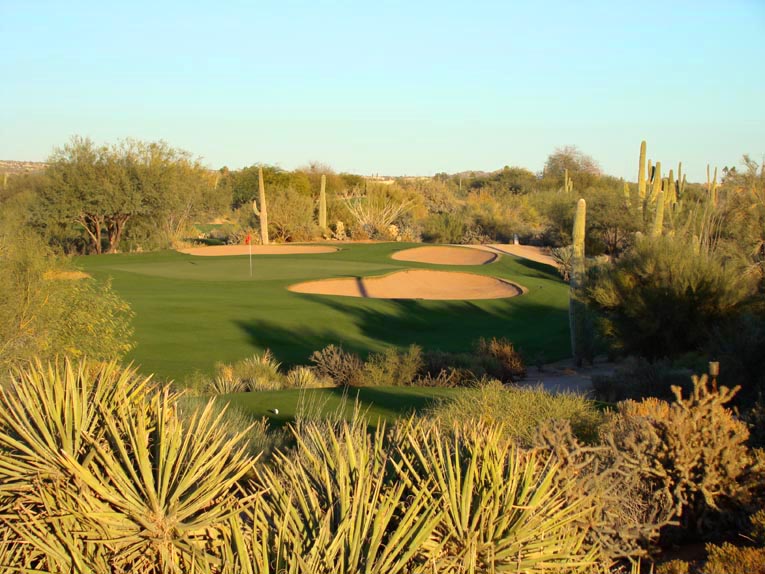
Not without humor, the members at Desert Forest have dubbed some of the yuccas around the course Johnny Bench and Yogi Berra as they catch anything that goes near them. The ones above are unnamed as they are just off the tee but what this photograph illustrates are the left and right wings to this 31 yard deep green. Totally different shaped shots are required depending on the day’s hole location which is one of the reasons that better golfers are devotees of the course.
Eighteenth hole, 420 yards; Routed cross drainage, Lawrence’s undulating fairway makes for a perfect conclusion. Thinking back, the itinerant golfer might be surprised at least two fold by Lawrence’s design. First, while the desert is an integral part of the golf course there are few ‘death or glory” shots forced over large swaths of desert. Apart from the wash at the seventh hole (and even that one is set on a diagonal), the golfer never crosses the desert floor unless his ball is on a tee. Every fairway flows without interruption to the green, meaning that all golfers can grow old comfortably enjoying Lawrence’s shrewd design. Second, the golfer may be shocked to realize that he didn’t confront a single fairway bunker throughout his round. Lawrence either bent the fairway corridors using the natural desert landscape to preserve the integrity of the inside of the doglegs or he captured the undulations of the desert floor within his fairway corridors (such as here at the eighteenth) to lend the holes strategic purpose. Either way, he saw no need to create artificial hazards by man (i.e. bunkers!) in the fairways.

One can only admire the pristine view afforded from the eighteenth tee. No heinous 50,000 square foot clubhouse exists to spoil the connection with the beautiful high desert.
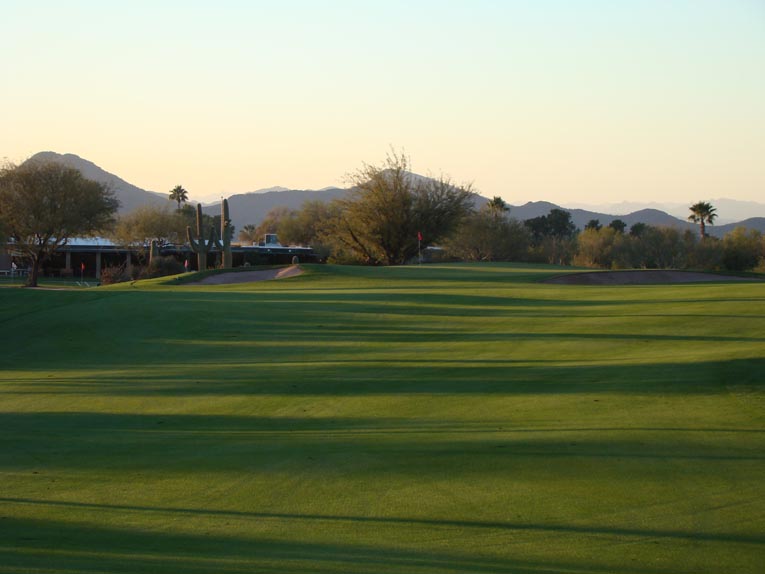
Note how the cozy single story clubhouse snuggles low into the surrounds, reflecting the low key, understated attitude that prevades the club.
As a premier retirement area boasting plenty of sunshine and a climate conducive to healthy living, the greater Phoenix area naturally draws people from around the world. Golf – at least traditional golf – certainly can play an important role in a well balanced, healthy life. While much of the northern hemisphere is frigid from October to April, members here can take a five mile stroll under bright blue skies and enjoy long sweeping views in every direction.
Golf has changed quite a bit since Red Lawrence passed away in 1978. In America it has morphed so that many equate golf with a ride in a cart. Others fancy water hazards (in the desert of all places!), flashy bunkers, or a big clubhouse to affirm one’s self-importance. Not so at Desert Forest which remains a bastion for traditional golf in a region of the country not known for embracing that form. Literally, the southwest is as far removed from the United Kingdom and the home of golf as any part of the United States. Fortuitously, the trail blazer Red Lawrence bridged that gulf when he brought Northeast golf sensibilities to the great Southwest.
The club continues to foster and nurture those virtues to this day, making it a beacon for those who appreciate the qualities of traditional golf.
The End


